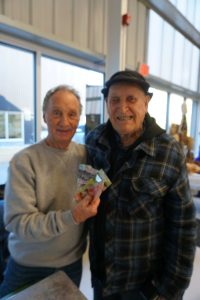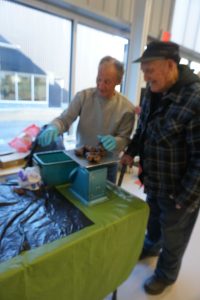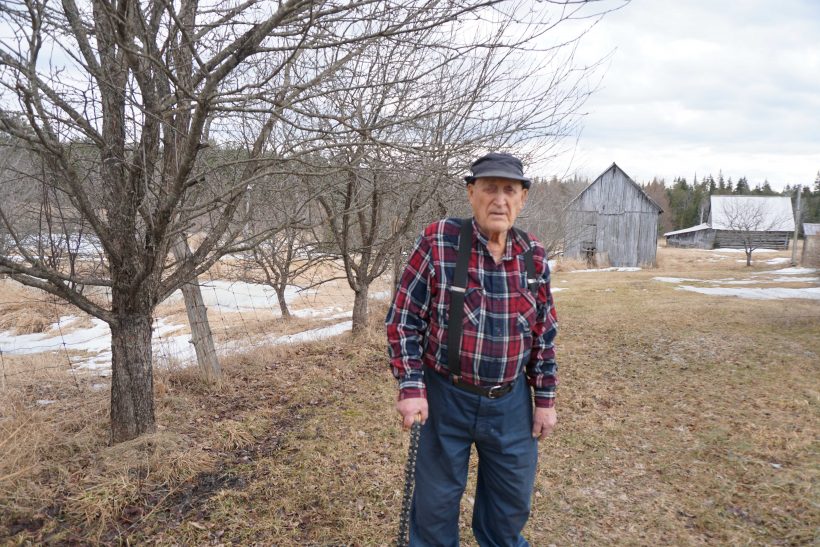THE HAPPY CENTENARIAN
Happy 100 to Bill O’Brien, no stranger to this column. Until the Covid-19 virus befell us Bill used to travel west to hunt with his sons. During the winter he and his trapping partner continued to collect pelts. We last talked in person at the Apsley Fur Harvesters’ Carnival where he was selling beaver castors. Bill was born May 6, 1921.
97 YEARS YOUNG
Passed a pleasant afternoon with William (Bill) O’Brien maybe 100 metres east of the house where he was born, May 6, 1921, and raised by his parents John O’Brien and Nellie (nee Gerrard). We were sitting at his kitchen table in the house he built in 1945 on land his father provided. His apple orchard was just to the east. “Various varieties,” he told me, uncertain of specific species. Bill recalls that Mrs. Unger, a mid-wife, delivered him at home. He has 4 sisters and 2 brothers, all born at home with the exception the youngest, Carl, who was born at the Coe Hill Red Cross First Aid Station. Bill being the 3rd eldest. One sister and two brothers are still living. He has lived his entire life here raising 3 sons and one daughter birthed by his first wife, all presently with successful careers.
Bill remembers a Dr. Wade and Dr. Hardinge of Welch’s Corners. Hardinge also built the community’s first telephone exchange apparently making the switchboard from an old sewing machine stand. Bill recalls that “the birds used to nest in one of his telephone poles.” Continuing, Bill passed along a story told to him by friend, Harold Reid.
“Dr. Hardinge diagnosed me with appendicitis. He gave me some medicine, wrapped me in ice and said, ‘if you are alive in the morning you’ll never have appendicitis again.’”
“And he lived,” emphasized Bill.
Bill went as far as grade 8, hoofing it the 2.9 miles, one way, not necessarily uphill both ways, to the Gilroy school. Twice a day two boys were sent to fetch a pail of water from a nearby stream. “We all drank from that pail, with the same dipper – and didn’t die!”
Someone was paid 5 or 10 cents a day to start the morning fire at school when it was required. “That was good money. There was a lot of interest in the job.”
Bill fondly remembers driving around accompanying his father in their Model T at a time when many had no car. Most travelled by horse. During the winter Lower Faraday Road was often closed and he remembered that one year his aforementioned friend Harold Reid was the first person to drive that road. At the time that “was a big thing. It made the news.”
One of Bill’s first jobs was in the bush, as a logger, earning $45 for the season including room & board. Nearby Salem, formerly Welch’s Corners, was the major local centre until the iron ore mines opened in Coe Hill and everyone began building there. A combination of too much sulphur in the ore and falling world iron prices doomed the Coe Hill iron mines to a brief existence.
Now there are but a couple of houses and a cemetery in Salem.
Bill met his wife while she was teaching at the nearby Lower Faraday school. When courting, Bill recalls travelling to Toronto to see her. “Bloor and the Danforth was the centre of Toronto.” They celebrated their honeymoon at Niagara Falls, staying one night in Oakville. “It was just a small village, like Coe Hill, at that time.”
Bill’s father gave him 10 or 11 acres to build his home.
For 19 years Bill drove a feeder-school bus; mostly Chevs he bought from Bill Domm’s dealership in Apsley. Readers may recall MP Domm who championed a return to Canada of the death penalty.
In 1952 O’Brien was elected to the Wollaston council eventually serving as Reeve in 1964. Bill fought to save the Central Ontario Railway spur line to Coe Hill. “One train couldn’t transport all of the forestry products at one time,” he emphasized. Some of the logs were used to build the Toronto subway. The irony of shutting down the rail line in 1966 wasn’t lost on Bill during Canada’s Centennial Celebrations. After all, it was the rail that ultimately physically brought Canada together as a Nation.
Looking through Bill’s photo albums highlights local deer adorned with horns the likes of which I have never seen. When he was 95 Bill went west to deer hunt with one of his sons and shot two deer. He talked about fishing with his dad at Ferguson Bay on Wollaston Lake. “We would rent a row boat from Sam Ferguson for one dollar a day.” Unlike many in the area Bill preferred bass to lake trout. The local fishing was great but that didn’t stop him from taking trips to Elliott Lake and Great Bear Lake. Locally, “We fished to eat.”

Wild turkey are now in the vicinity – “Up the road there are some nice flocks” – deer are plentiful (I saw two healthy does during my exit). Although he hasn’t seen any elk, many years ago Bill’s Uncle Bob shot one near the Moore farm on The Ridge Road.
Although there are pockets of moose presently in the area they were a rarity when Bill was a boy.
“We had a dog that ran anything – horses, cows… Socks, that was his name, would run all day.” One day, when Bill was hunting with his 30.30 Socks gave chase to a large dark animal that Bill didn’t recognize. Turns out he shot a cow moose in front of Socks. “It was large and dark. Noone knew what it was.” Even his dad and veteran hunter Fred Smith. “They were so scarce.”
There were always lots of bear. “I used to guide some americans.”
One day Bill was with Harold Crosby at the gravel pit, preparing to cut hay when news arrived of a bank robbery in Havelock. “We never locked anything up,” said Bill. “So I had to send the kids to get the keys that I left in my car,” he said with a chuckle.
As for the weather, “It definitely is getting warmer. 75 years ago when lumbermen used horses to skid the logs out of the bush and across the creeks the ground had to be frozen. To-day they couldn’t exist.” BUT, Bill remembers when the thermometer dipped to -52F. “Mother wrapped me up and sent me off to the Gilroy School.”
Later I met up with Bill at the Apsley Trappers’ Carnival. He had shown me a photo of the first wolf that he trapped about 80 years ago. According to Bill wolves are more common to-day.
“I’ve been trapping 90 years.” That usually perks up one’s ears as if to say, “Did I hear that correctly?”

Bill has a partner who does most of the field work. Bill then skins, scrapes and prepares the hides for sale at the Fur Harvesters Auction. At this time he had 35 hides for sale. At the carnival Bill brought beaver castors and received $85 for one pound; considerably more than the average beaver pelt of $14.00. (The castors are sold to Europe for perfume.)
Bill had as many as 50 head of cattle at one time. He started driving at 20, fondly recalls his 37 Dodge Coup, still drives his truck, takes a test every two years and claims he could drive the Lower Faraday with his eyes shut. In parting, Bill proclaimed, “I’m the Senior senior of Coe Hill; don’t know of anyone older!” And Bill is waiting to see if he has successfully won a moose tag for the fall season.
UPDATE
“The Wednesday edition of The Bancroft Times, December 25, 2024, page 9, announced the passing of Bill, age 103 on December 17, 2024 in the Hastings Centennial Manor at Bancroft.
William O’Brien ‘Bill’ was born at home on a farm near Coe Hill on May 6, 1921 and lived near there at 109 O’Briens Road for nearly 100 years. …Bill and Ruth raised their four children in a small house that Bill built in the mid-forties on a 10-acre parcel of land adjacent to his parent’s farm. Although Bill was a farmer he did whatever it took to make a living and provide for his family. He cut logs in the wintertime and sold them to local mills. When the beaver population spiked in the late fifties he started trapping. He enjoyed trapping so much that he continued into his early 90’s even though the price of fur had collapsed. Bill became the first school bus driver on the Lower Faraday Road when his children reached high school age. Odd that he had held this job for roughly 20 years considering that he was totally blind in one eye. He also had the foresight to realize that one of his fields that would only grow a poor crop of hay in a good year was better suited to be a gravel pit. The pit has been operational for the past 50 years and is still the main gravel pit for Wollaston Township. Although farming was very demanding on Bill’s time he found the time to be the leader of the Wollaston 4-H club in the early sixties. He was no stranger to community service serving two terms as a Councillor and one term as the Reeve for Wollaston Township. Bill was a Shriner and a member of the Masonic Lodge for many decades. He was also a member of the Orange Lodge. Bill loved hunting and fishing as noted in the above article.”
